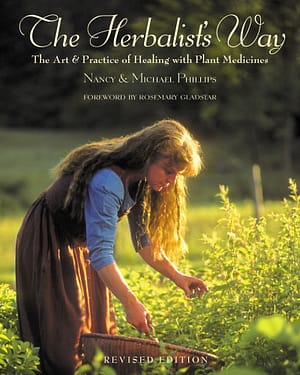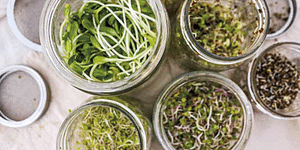10 Herbs for Family Health

Growing your own herbs is a great alternative to over-the-counter medicine. Not only do these plants help with general wellness, they’re also an easy fix for small cuts, be used as a calming agent, and boost your immune system.
Have more control of what goes into your body with these 10 herbs to promote natural well-being.
The following is an excerpt from The Herbalist’s Way by Nancy Phillips & Michael Phillips. It has been adapted for the web.
Herbs for Family Health
Growing and wildcrafting my own medicinal herbs and making herbal preparations with them is one of my greatest joys.
I’ve become empowered to take charge of my health, to nurture my family’s well-being, and to find myself deeply connected to Earth in the process.
Choosing ten herbs to get to know and befriend is a great way to begin on the herbal path. Research and experiment with them. Use these herbs for minor family illnesses and to promote overall health and well-being.
How to Use Medicinal Herbs
Practice making herbal preparations such as teas, tinctures, salves, syrups, and body care products. Choosing plants you can grow or wildcraft yourself deepens this relationship considerably.
The real insights of herbalism come when you spend time with living plants. A year spent cultivating and harvesting your medicinal plants provides a far better understanding than just reading about an herbal remedy purchased elsewhere.
We grow well over a hundred medicinal herbs on our farm, so narrowing the list to ten family favorites is always difficult. How do you decide which good friends not to invite to a party? Nevertheless, the following are ten plants I wouldn’t want to live without here in New England.
1. Echinacea

Echinacea is a beautiful perennial that grows about three to four feet tall. There are at least nine species of echinacea, three of which are commonly grown for medicine: angustifolia, pallida, and purpurea.
Echinacea angustifolia, native to the midwestern United States, is relatively difficult to grow in the Northeast. We have been growing Echinacea purpurea successfully for years, as it’s very easy to grow and highly effective as a medicinal.
How to Grow These Herbs
We start it inside from seed, but it also readily self-seeds. The first year we don’t harvest anything from the plant, but we speak sweetly to it when passing by or cultivating.
The second year plants are lightly harvested for leaves, flowers, and seeds to dry for tea and use in tincture form. We wait until plants are at least three years old to harvest the roots.
Healing Properties
Echinacea is known as the king of the blood purifiers. It is used to help the liver function better and is widely respected as a natural immune enhancer. Native Americans used it for treating venomous bites and stings and other poisonous conditions.
Modern research has shown that echinacea increases white blood cell growth, thus helping to fight infections and viral conditions. We do not use echinacea every day in our family, but rather to “jump-start” our systems at the first onset of an itchy throat or a sniffle.
How to Use These Herbs
This herb always helps when it is combined with other good health practices and enough of it is used. One-half to one full teaspoon of tincture given every couple of hours is usually an effective dose for an acute situation.
This varies depending on an individual’s weight, physical stamina, the quality of the tincture, and the affliction.
2. Garlic
Garlic stands tall as one of our family’s most called-upon herbs. It has been used for food and medicine in many cultures for centuries.
Often it is recommended to help control high blood pressure and arteriosclerosis. We feature this antibiotic herb regularly in miso soup whenever any of us shows signs of flu symptoms.
How to Use These Herbs
I occasionally suck on a whole clove to rid myself of a sore throat. A few other brave souls in the family now use this sure cure as well. One coworker responded to this suggestion with, “Yuck! I would rather be sick”. . . and I guess she would.
Olive oil can be infused with garlic alone or a mix of garlic and mullein flowers for ear infections (but not if the ear is perforated). I also formulate these potent cloves with other herbs to make a strong immunity tincture.
Plant garlic cloves in the fall, a few inches deep, and come the next summer you’ll have gourmet medicine aplenty.
3. Valerian
Valerian can grow as high as six feet. This beautiful perennial herb is grown easily from seed and also self-seeds regularly.
We harvest the roots in the fall after a hard frost to use in tinctures or tea. Valerian is probably the most commonly recommended herb for insomnia.
How to Use These Herbs
This natural sedative can also be used in smaller doses as a general nerve tonic. Although valerian is relaxing and sedating for most people, 4 to 7 percent of the general population have the opposite reaction to it: They become stimulated.
So try out your valerian at an opportune time, rather than waiting until you are tossing and turning and need a good night’s rest.
4. Comfrey
Comfrey is another favorite. I can’t imagine having a medicinal herb garden without a comfrey plant to grace it. The trick with comfrey is to pick the spot you want it to be in forever when you first plant it.
The roots can grow to be ten feet long, and a new plant can grow from a one-inch piece of the broken root.
How to Use These Herbs
Comfrey has been used internally and externally for hundreds of years, though currently a controversy centers on its safety for internal use. You’ll need to research the subject to make your own decision.
A poultice of the leaf helps heal fractures, sores, and cuts. My favorite healing salve features this herb. I also find comfrey to be a beneficial ingredient in formulas for respiratory tinctures and teas because of its soothing, mucilaginous, and expectorant qualities.
5. Catnip
Catnip deserves a place in your garden or herb pantry, cats or no cats. This stimulant for kitty is a very gentle, relaxing herb for the rest of us.
A nursing mother can drink its tea to help a colicky baby, or she can give the baby small amounts of an infusion in a bottle or by spoon. Catnip tea helps a stomachache or indigestion caused by gas.
How to Use These Herbs
Combined with elder, peppermint, and yarrow, catnip aids in bringing down a fever. This plant readily self-seeds, so once you get a plant started, it will continue to sprout somewhere in your garden each year.
Harvest the upper third of the plant when it is just beginning to flower or when it looks vibrant enough to call out: “Hey, look at me. I’m ready to share my healing spirit!”
 6. Stinging nettles
6. Stinging nettles
Stinging nettles planted in the garden may seem like the act of a madwoman, but if you don’t have easy access to a great wild patch, then find a secluded spot in your garden for it.
Nettles can be started easily from seed, cuttings, or root divisions. This plant demands our attention—you’ll get stung if you’re not mindful— reminding us to tune in and listen to our green teachers.
How to Use These Herbs
All parts of the nettle can be used medicinally. I use the leaves almost daily as tea, but we also steam them to eat plain or in any recipe that might call for spinach.
We dry plenty of nettle for winter use. This herb helps the liver to purify the blood, as it is loaded with vitamins, iron, and life-giving chlorophyll.
The formic acid in the little hairs on the stems and leaves causes the sting. Some people use the sting itself to help in their treatment of arthritis. The sting goes away when the herb is dried or cooked.
7. Peppermint
Peppermint, my dear peppermint, I wouldn’t want to be without her!
When most of America wakes up in the morning and longs for that first cup of coffee, some of us can’t wait for our gently stimulating cup of peppermint. This herb nourishes the nervous system and keeps the emotions on an even keel.
Growing These Herbs
Peppermint does have the habit of wanting to run all over the garden, spreading by its root runners. This plant needs a contained area or a strong disciplinarian to chop it out when it sneaks beyond its assigned spot.
You can keep it happier in its contained area by taking chunks out each spring and composting the rest.
True peppermint should be started by root division or cuttings, not from seed, as the seed does not always produce the same strain of mint as the mother plant.
My absolute favorite variety is the black peppermint (Mentha × piperita) grown for commercial production because of its strong flavor. Peppermint is invaluable for adding to other formulas to help improve the taste and palatability of the remedy.
8. Chamomile
Chamomile is gentle enough to give to a baby, but a tea of it is strong enough to help ease tension headaches and painful menstrual cramps. This antispasmodic herb also helps as a digestive aide.
The annual German chamomile (Matricaria recutita) is our favorite. We started it by seed directly in a prepared garden bed twelve years ago, and it has faithfully self-seeded somewhere in the garden every year since.
Picking these dainty little flowers in early summer can be meditative and healing in and of itself.
 9. St. John’s wort
9. St. John’s wort
St. John’s wort has gotten a lot of media attention for being a natural antidepressant. It is used to treat anxiety and depression without many of the negative side effects that synthetic drugs such as Prozac induce.
Growing These Herbs
This wild herb commonly grows in fields and along roadsides, but if you want to harvest a lot, plant an abundant patch in your own garden.
Harvest the beautiful yellow flowers right before the buds open to make infused oils and salves. We clip the top three inches of leaves and buds to dry for tea and tinctures.
How to Use These Herbs
You don’t have to be severely depressed to benefit from a little St. John’s wort—a gentle nervine tea can be made with equal parts of lemon balm, chamomile, milky oats, and St. John’s wort.
Someone who is severely depressed should work with a knowledgeable health care provider in determining the proper dosage and other therapies.
10. Goldenseal
Goldenseal is not easily grown in every garden. I mention this valuable medicinal here to encourage you to try cultivating your own.
This somewhat delicate woodland plant grows best in 75 percent shade in deciduous forests. A moist, rich, woodland area is its preferred habitat, but the shade beneath a hedge has been known to serve as well.
Growing and Harvesting These Herbs
Because it is scarce due to loss of natural habitat and overharvesting, only cultivated goldenseal should be used. The powdered root is quite expensive to buy, running about $100 a pound.
Goldenseal roots are small, and the plant does not reproduce readily. Harvest occurs from the fourth year on.
This natural antibiotic and infection-fighting herb should not be used for extended periods, because it can irritate the body.
Using These Medicinal Herbs
You can get started with my ten suggested herbs or choose from many other valuable plants, but start to use herbs for family health. Pass on your newfound knowledge to your children.
Gracie loves to take people on a stroll through our gardens, grazing on edibles and explaining the virtues of peppermint, echinacea, and her favorite heartsease pansies, the Johnny-jump-ups. No one goes away without the offer to eat “a jumper.”
It warms my heart knowing the chain of herbal knowledge will continue with my daughter.
Recommended Reads
Recent Articles
Want to start your own medicinal herb garden? Passionflower, lemon balm, and goldenseal are great places to begin! These herbs are jam-packed with medicinal properties and easy to grow in a majority of climates.
Read MoreSprouts are easy to cultivate, mature quickly and pack a nutritional punch! You can make nutrient-rich sprouts from all kinds of edible seeds in your kitchen.
Read MoreSuffering from frequent headaches is miserable and immobilizing. If you haven’t had luck treating and preventing your headaches, skip the over-the-counter approach and prepare herbal formuals for migraines to use in the future! The following is an excerpt from Herbal Formularies for Health Professionals, Volume 4 by Jill Stansbury. It has been adapted for the…
Read More“It is more important to know what kind of person has a disease than to know what kind of disease a person has.” —Hippocrates Drawing on her decades of clinical experience and her extensive research, Dr. Jill Stansbury offers an unparalleled range of herbal formulas in her five-volume set, Herbal Formularies for Health Professionals. For each…
Read MoreUsing herbal medicine to heal the body is an ancient practice. It has since become a worldwide industry. Today, modern-day doctor’s visits and industrial medicine have displaced common knowledge of herbal medicine. Some still remember the ancient practice. In her book Following the Herbal Harvest, Ann Armbrecht interviews one such person, Phyllis Light, a fourth-generation…
Read More










